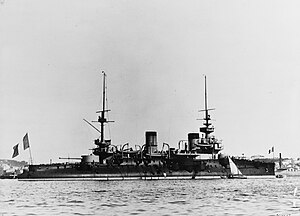 French battleship Bouvet
| |
| Class overview | |
|---|---|
| Preceded by | Masséna |
| Succeeded by | Charlemagne class |
| History | |
| Name | Bouvet |
| Namesake | François Joseph Bouvet |
| Builder | Arsenal de Lorient |
| Laid down | 16 January 1893 |
| Launched | 27 April 1896 |
| Commissioned | June 1898 |
| Fate | Sunk during operations off the Dardanelles on 18 March 1915 |
| General characteristics | |
| Type | Pre-dreadnought battleship |
| Displacement | 12,200 t (12,007 long tons) |
| Length | 122.4 m (401 ft 7 in) (loa) |
| Beam | 21.4 m (70 ft 3 in) |
| Draft | 8 m (26 ft 3 in) |
| Installed power |
|
| Propulsion | |
| Speed | 18 kn (33 km/h; 21 mph) |
| Range | 3,000 nautical miles (5,600 km; 3,500 mi) at 9 knots (17 km/h; 10 mph) |
| Complement |
|
| Armament |
|
| Armor |
|
Bouvet was a pre-dreadnought battleship of the French Navy that was built in the 1890s. She was a member of a group of five broadly similar battleships, along with Charles Martel, Jauréguiberry, Carnot, and Masséna, which were ordered in response to the British Royal Sovereign class. Bouvet was the last vessel of the group to be built, and her design was based on that of Charles Martel. Like her half-sisters, she was armed with a main battery of two 305 mm (12 in) guns and two 274 mm (10.8 in) guns in individual turrets. She had a top speed of 18 knots (33 km/h; 21 mph), which made her one of the fastest battleships in the world at the time. Bouvet proved to be the most successful design of the five, and she was used as the basis for the subsequent Charlemagne class. Nevertheless, she suffered from design flaws that reduced her stability and contributed to her loss in 1915.
Bouvet spent the majority of her peacetime career in the Mediterranean Squadron conducting routine training exercises. This period was relatively uneventful, though she was involved in a collision with the battleship Gaulois in 1903 that saw both ships' captains relieved of command. In 1906, she assisted in the response to the eruption of Mount Vesuvius in Italy. Bouvet was withdrawn from front-line service in 1907 and thereafter used as part of the training fleet. The ship was the only vessel of her group of five half-sisters still in service at the outbreak of World War I in July 1914.
A significant portion of the French Army was stationed in French North Africa, so at the start of the war, Bouvet and much of the rest of the fleet were used to escort troop convoys across to southern France. With this work done by late August, Bouvet and several other battleships were used to patrol for contraband shipments in the central Mediterranean. From November to late December, she was stationed as a guard ship at the northern entrance to the Suez Canal. The ship thereafter joined the naval operations off the Dardanelles, where she participated in a series of attacks on the Ottoman fortifications guarding the straits. These culminated in a major assault on 18 March 1915; during the attack, she was hit approximately eight times by shellfire but was not seriously damaged. While turning to withdraw, however, she struck a mine and sank within two minutes; only 75 men were rescued from a complement of 718. Two British battleships were also sunk by mines that day, and the disaster convinced the Allies to abandon the naval campaign in favor of an amphibious assault on the Gallipoli Peninsula.